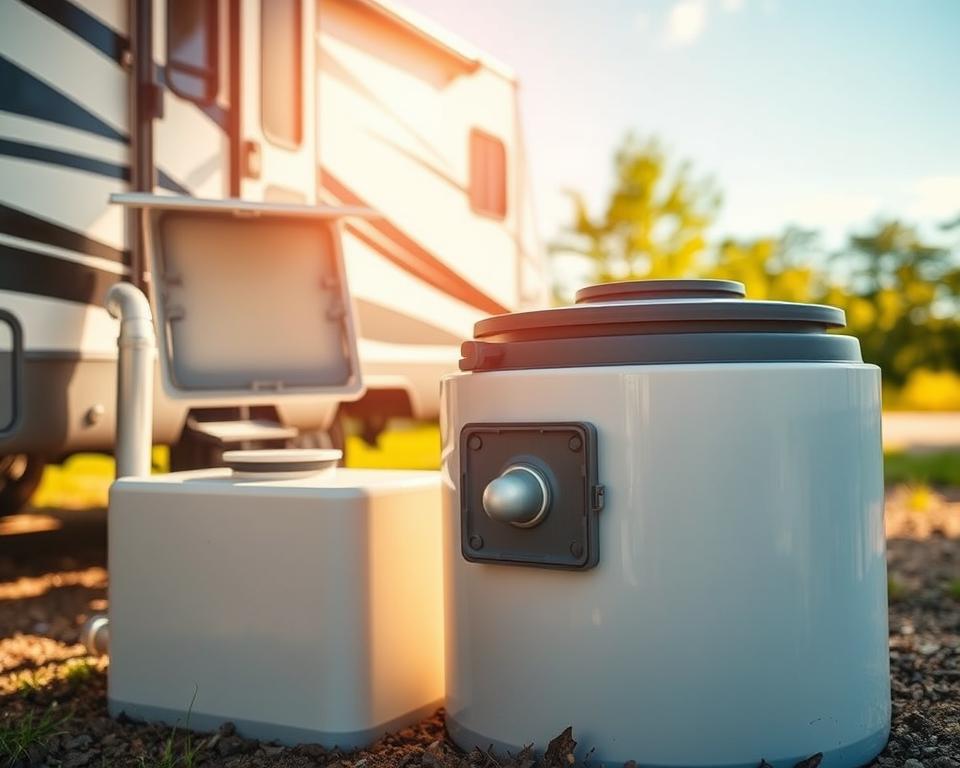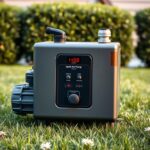RV Waste Tank Pumping: Vital Maintenance Advice
Imagine what happens when you ignore your RV’s sewer setup. Many RV owners find the idea of septic tank pumping daunting. Yet, realizing the importance of these maintenance practices is vital. Such measures keep your trips worry-free and prevent costly fixes. Mastering correct waste handling is fundamental to your system’s longevity. We’ll share vital insights on RV septic pumping near me, including best practices and tips to keep your system running smoothly.
The Basics of Your RV Sewage System
Your RV includes tanks designed for different wastes. It consists of a black tank for toilet use, a gray tank for sinks/showers, plus a freshwater reservoir. Grasping how each part works is key to proper black tank servicing and overall system care.
Drains and vents manage liquid and air movement throughout the system. Understanding this synergy helps you avoid blockages and buildup. It’s the foundation of a smooth camping experience.
Maintaining clear, working tanks requires routine effort. Monitoring fill levels and dumping when needed keeps odors at bay. By maintaining your RV’s septic system properly, you’ll improve its lifespan and enjoy every trip more.
Why Routine Tank Pumping Matters
Routine sewage draining preserves functionality and hygiene. Leftover solids lead to smells and clogs, spoiling your trip. Overfilled tanks risk ugly overflows. Such mishaps kill the fun on the road.
Skipping pump-outs leads to pricey repairs. System failures cause leaks and wear out parts prematurely. Timely emptying keeps your plumbing running smoothly. It prevents unwelcome surprises and roadside emergencies.
Staying on top of maintenance wards off backups. Investing in pump-outs shows you care about your RV. It greatly improves your travel experience. A strict pumping routine lets you enjoy camping without septic concerns.
Finding the Right Dump Frequency
Determining dump intervals needs careful thought. Common guidance suggests a 3–5-day window. However, it shifts based on tank volume and number of users. Pinpointing the correct dump time is key for effective wastewater management.
Dump the black tank at about two-thirds capacity. It ensures good drainage and cuts down on odors. Skipping this leads to blockages and smells that spoil the trip.
Various factors influence dump frequency, such as
- Number of people on board
- Length of stay
- Type of waste generated
- Tank capacity
Planning is key to avoiding emergencies. Remember portable toilet service schedules. Tracking your usage helps forecast dump needs.
| Usage Scenario | Pumping Frequency |
|---|---|
| Short Trip, Two Campers | Every 3–4 days |
| Long Stay, Four to Six Occupants | Every 2–3 days |
| Seasonal Living (2–4 people) | Weekly or Bi-Weekly |
Keep a close eye on tank levels and your habits. This proactive stance ensures enjoyable travel.

Proper Tank Dumping Techniques
Proper methods stop odors, clogs, and expensive repairs. Always empty the black tank first to protect the gray tank. It keeps gray water from mixing with solids.
A sturdy sewer hose reduces spill chances and aids flow. Tighten connections to stop spills. After emptying, flush the black tank with plenty of water. It clears lingering waste for a cleaner tank.
Scout dump spots along your route. This preparation streamlines your dump routine.
In short, follow these key steps for efficient dumping:
- Empty the black water tank first.
- Use a top-quality sewer hose.
- Flush the black tank thoroughly after emptying.
- Plan your dump station locations.
Following these guidelines simplifies black tank maintenance.
How to Care for Your Black and Gray Tanks
Knowing proper tank use and maintenance is crucial. Keep some water in the black tank for better breakdown.
Refrain from disposing non-biodegradable items. Always use RV-safe toilet paper to prevent clogs. Regular checks spot leaks or cracks before they worsen.
Occasional treatments boost system performance. These products balance enzymes and bacteria for efficient decomposition. Simple steps ensure smooth tank operation.
- Check for leaks and damage often.
- Apply RV-specific chemical treatments.
- Keep vents clear to avoid odors.
Following these rules protects your septic setup. It also boosts your camping enjoyment.
How to Pump Efficiently
Successful pumping requires precision and a clear procedure. It’s essential to use designated dump stations. Understanding volume limits prevents spills on the go.
Monitoring levels guides your dump schedule. Routine scheduling preserves your septic system and travel enjoyment. Setting a dumping schedule improves system efficiency.
Flush well after every emptying. It ensures each dump is cleaner than the last. By applying these strategies, you’ll maintain your RV’s condition and comfort.
Avoid These Septic System Errors
Maintaining your system is vital for uninterrupted camping. Not using enough water in the black tank leads to buildup. Adequate water use breaks down solids efficiently.
Flushing inappropriate items blocks pipes. Only biodegradable RV-safe items belong in the black tank. They cause backups and costly service calls.
Keep the black tank valve closed until ready to dump. Open valves let water out but hold solids, causing residue. This ensures solids clear on each dump.
Knowing these pitfalls helps maintain efficiency. Avoiding them keeps your waste management reliable.
When to Seek Professional Septic Services
Knowing when to hire pros preserves system health. Persistent odors often indicate complex issues. Slow drains point to potential clogs or buildup.
Waste spillage near dump sites signals trouble. It often calls for a deep professional clean. Pros blast away blockages to restore smooth flow.
Routine professional inspections catch hidden issues early. Acting on findings quickly prevents bigger problems. Hiring qualified technicians saves time and money long term.
Long-Term Maintenance for Your RV Wastewater Management
Smart upkeep ensures lasting system performance. Scheduled dumps preserve longevity and operation. Routine rinses clear residue and stave off expensive breakdowns.
Adopting sanitation routines protects your system. Checking seals and joints avoids leaks. Choosing eco-friendly treatments avoids damage.
Consider these long-term practices:
- Stick to a pump-out timetable.
- Rinse often to remove solids.
- Sanitize twice a year.
- Inspect parts frequently for wear and tear.
Proactive care delivers worry-free travel. Through consistent upkeep, you’ll enjoy travel free from waste worries.
To Summarize
Good septic care ensures enjoyable trips. Understanding operation and following guidelines prevents headaches. Routine black tank dumping boosts performance. It enhances every mile.
Consistent inspections and care deliver trouble-free trips. Dependable sewage service backs every adventure. These routines prime your rig for future rides. Thus, you can concentrate on adventures rather than septic concerns.

